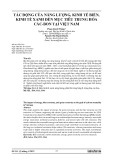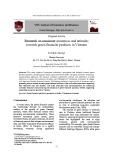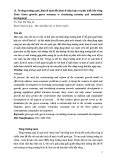
THE HYDROGEN CIRCULAR ECONOMY: ESTABLISHMENT OF
AN ADVANCED HYDROGEN INDUSTRY TOWARD VIETNAM
NET ZERO 2050
Tran Thien Khanh1, Nguyen Thanh Duy1, Nguyen Thanh Luan1, and Huang Jyh Leu2,*
1Dong Nai Technology University
2Feng Chia University, Taiwan.
*Corresponding author: Huang Jyh Leu, hjleu@mail.fcu.edu.tw.
GENERAL INFORMATION ABSTRACT
Received date: 01/05/2024
In recent years, the development of hydrogen as a new reliable
energy source has become a trend and caught lots of attention
from all over the world. Hydrogen is a fundamental element
that can be produced via different processes, which can be
classified into three main groups: green processes
(electrolysis), carbon-
treated processes (thermoconversion
processes), and traditional processes (reforming processes).
Hydrogen products were identified using their specific color
such as green, blue, and brown hydrogen… Clean hydrogen
(blue and green hydrogen) possesses strong energy density, is
a renewable energy source, is produced without emissions, and
possesses high economic value. However,
the sufficient
solution to produce hydrogen on a large-scale level must be
done based on a well-
prepared hydrogen economy; this
hydrogen economy must be directed towards the goal of a
circular economy model, using green energy, and following
the route of carbon-
neutral industries or other production
activities. In that manner, the hydrogen industry development
roadmap must combine the advantages of geographical
conditions, appropriate technologies, and compliance with the
support policies of each country an
d region. Building a
hydrogen economy is specific to its intended use, needs to be
built on a scale from small to large, and deployed based on an
economic model that can promote the advantages in the
production process, create a flexible mechanism in the product
storage and distribution process, and finally create
convenience in replicating the production model that may
easily bring products to end users. Recognizing all those
concerns, the concept of the circular hydrogen economy was
born and is predicted to be the dominant model in the
hydrogen industry worldwide. Clarifying the role of the
circular economy in the establishment of a circular hydrogen
economy model plays a key role in this research; Accordingly,
the advantages and disadvantages of the circular economy are
also analyzed and presented, through the comparison and
conclusion obtained from case studies conducted in other
countries.
Revised date: 13/05/2024
Accepted date: 28/06/2024
KEYWORD
Circular economy;
Hydrogen economy;
Hydrogen production;
Renewable energy.
98

1. INTRODUCTION
Energy plays an important role in the
development of countries, especially in
industrial production, optimally serving the
process of industrialization and modernization.
However, humanity's excessive abuse of
resources such as gas, coal, and fossil-related
materials... creates many negative impacts on
the environment which is also accompanied by
the phenomenon of climate change, natural
disasters, and thus creating many harmful
effects on the world of men. These effects also
endanger the world’s ecological structures and
creatures’ behavior; not only that, it also
negatively crashes the social development, and
economic systems from regional to
international. Accordingly, the need for a useful
energy solution toward a more sustainable
future has become a very trending and
important task. Therefore, indicating a new and
viable energy source will play a crucial role in
the mentioned energy solution (UN General
Assembly et al., 2015; Nick et al., 2019). In the
current context, hydrogen is emerging as a very
promising candidate that can replace traditional
resources in creating a new energy industry that
is renewable, cleaner, more efficient, and safer
(Dominique et al., 2021; Nguyen et al., 2020).
Hydrogen possesses excellent physical and
chemical properties and can be applied very
flexibly in many modern industries, such as the
automobile manufacturing industry, energy
industry, food industry, transportation
industries... However, the development of a
reliable hydrogen industry can only be
accomplished on a solid foundation of a
hydrogen economy system.
However, to enable the establishment of a
hydrogen economy and thereby successfully
create a hydrogen society, the problem of
resource supply and the specifics of products
need to be resolved. While the natural source of
hydrogen is too small, traditional hydrogen
production has failed to create a positive impact
and would not be able to serve humanity's
requirements for the new era (Fran et al., 2022).
The development of hydrogen energy is
expected to make a difference and bring new
values to the global energy plan, which is
interdisciplinary and possesses very different
characteristics depending on the energy policy,
infrastructure, and plans of each country.
Currently, there are about 75 operating
hydrogen production factories and 150 facilities
in the planning stages of development
worldwide (mainly in the US and China), the
number of projects and underdeveloped plants
for hydrogen industries is assumed to be twice
those that were reported (Zoback, Smit et al.,
2023). Although the cost of hydrogen
production is still very high compared to other
types of renewable energy, researchers predict
that future production costs will gradually
decrease thanks to the development and
application of advanced technologies
(Environmental et al., 2022; Zun, McLellan et
al., 2023).
In the early 2020s, hydrogen consumption
is estimated to be around 87-90 million tons per
year, of which the demand for hydrogen is
expected to increase exponentially depending
on each industry group in the period of 2030 to
2050 (Global Hydrogen Review et al., 2022).
The global demand for hydrogen is growing,
which means opportunities to invest and
develop this industry are constantly appearing
and promising to create more than 30 million
new jobs, along with a source of income of up
to 2.5 trillion USD/year by 2050 (Marouani et
al, 2023; Tarvydas e al., 2022). According to
predictions, to achieve zero emissions by 2050,
the hydrogen market must be able to provide the
source (mainly supplying the transportation
sector and key industries) with a capacity of up
to 170 million tons by the end of 2030.
99

In this work, the authors indicate the
importance of building a circular hydrogen
economy and explain the great possibilities of
this model in building a sustainable hydrogen
industry worldwide, especially in the case of
Vietnam. The concept of a circular hydrogen
economy is new and was determined based on
the idea of circular economy and the supply
chain of hydrogen products. Accordingly, the
circular hydrogen economy possesses distinct
production, specific storage and distribution,
and safer, cleaner consumption processes. This
work also addresses the development and
advancement of technologies related to the
circular hydrogen economy that is considered a
key factor in improving the efficiency of energy
production, while also being effective in
reducing related costs. Not only that, there are
many suggestions on hydrogen energy
development policy in Vietnam that are also
mentioned and analyzed, thereby explaining the
prediction related to the ability to supply 600
million tons by 2050 to maintain energy
security, form a hydrogen ecosystem, and
establish a net zero emission society in Vietnam
and at many places worldwide.
2. METHODOLOGY
This work was conducted using the method
that concerns the relationship between the
theory of circular economy and broad data
acquired from questions and inquiries from the
field of energy industries. The mentioned field
of energy industries relates to policies from
many sources and especially from Vietnam, and
other scientific reports. This work also involves
creating recent developments of theories that
were described as hydrogen circular economy.
All data were evaluated and explained with
references with the use of plots and diagrams.
3. RESULTS AND DISCUSSIONS
3.1. The demand for hydrogen as a new
reliable energy
The developing strategy for hydrogen has
been oriented in many countries, especially in
European countries since very early of 2015
and still growing strong, even though the
affection of the COVID pandemic during the
period of 2019-2021. According to Marouani
and his colleagues, the demand for hydrogen in
industrial production and transportation will
grow rapidly over time in the period 2035-2045
(Megia et al., 2021). Currently, energy
consumption is heavily dependent on fossil
fuels which equal to more than 85% of global
electricity consumption (22,850 TWh)
(produced from traditional processes and fuels)
(Le & Nguyen, 2023). This current situation, on
the contrary, does not hinder the development
of the hydrogen industry but also creates a
driving force to promote the development of
hydrogen technology (production, storage and
distribution technology, hydrogen consumption
technology) thereby creating a solid foundation
for reducing investment, establishment and
operation costs for hydrogen projects, moving
closer to realizing a hydrogen society.
The International Energy Agency (IEA)
indicates that the period of 2022-2025 will see
the hydrogen move to the global climate and
energy policy center stage. The IEA's World
Energy Outlook report shows that the cost
advantages of clean energy technologies are
gradually maturing, creating promising
premises for clean hydrogen production
technologies that require high investment costs
and interdisciplinary nature (Ballo et al., 2022).
Accordingly, by the end of 2022, there
would be more than 30 countries will have
hydrogen development strategies including
import and export plans, and the suggestion of
cross-border trade will grow significantly.
Therefore, countries that do not have a
tradition of energy exchanges are establishing
bilateral relations focused on hydrogen-related
technologies; Depending on the differences
100

between countries, the solutions to develop a
hydrogen economy would greatly benefit the
energy transition, and thus so are invested with
appropriate mechanisms and policies. suitable
(Razmi et al., 2023).
(The briefing on the advantages of hydrogen
energy can be found in figure S1 in the
supplementary materials)
Figure 1. The suggestion for hydrogen
demand/consumption in the period of 2030-2050
(Marouani et al., 2023).
3.2. The establishment of the circular
hydrogen economy – from philosophy to end-
users
The establishment of the hydrogen
economy is expected to be a prerequisite step to
developing the hydrogen industry toward the
building of a modern society using clean
energy, reducing carbon emissions, and
achieving the social status of carbon neutral. In
that spirit, building a hydrogen economy is
expected to not only create a foundation for
developing the hydrogen industry and
producing hydrogen products but also to
accomplish those tasks sustainably and
effectively in both production and
environmental protection aspects.
The hydrogen economy is established
based on the construction of three prerequisites:
the hydrogen production process is considered
the upstream source - creating hydrogen
products (1), the distribution network and the
hydrogen storage system are considered the
midstream transition factor – transporting the
product to the consumer (2), and the hydrogen
consumption process is considered the final
process of the downstream supply chain of all
types of hydrogen products (3). However, the
circular hydrogen economy conducts a new step
in completing the hydrogen supply chain – the
addition of the waste-utilizing process and
turning these waste products into a resource that
can serve as feedstocks of the hydrogen
production processes. In that manner, the
characteristics of the hydrogen economy must
be determined through four interrelated factors:
hydrogen production technologies, hydrogen
transportation and storage processes, hydrogen
consumption, and finally the processes that
utilize wastes and apply them as input materials
for the initial production process. The circular
hydrogen economy model is explained in
Figure 2.
Figure 2. The description of modern circular
hydrogen economy
Accordingly, this model creates a bridge
between production processes and related
ecosystems by continuously and effectively
addressing generated waste sources. The
circular economy focuses on solving the flow
of resources (both input materials and wastes)
rather than solving problems from the
perspective of increasing energy input and
enhancing waste treatment efficiency at the end
of these processes.
101

Therefore, the circular economy can be
applied and recognized via the process of
intelligently reducing input resources (reduce)
for production processes, making the most of
waste sources (reuse), and regenerating
(recycle) components suitable parts and
materials. From the perspective of establishing
a circular hydrogen economy, the authors
acknowledge that the story of building a
hydrogen industry is not new content, but the
circular hydrogen economy is a new approach
that creates added economic value and
contributes to reducing pressure on related
industries such as energy and emissions
treatment.
3.3. Circular hydrogen economy products and
technologies
The products of the circular hydrogen
economy are parts of the hydrogen industry
products, not all those products can be
recognized as hydrogen economy products,
except for those that fulfill the requirements
below:
භ Produced from input materials that are
output waste from another industry (industrial
wastewater, food industry waste products...) or
a renewable material source or originate from
nature (biomass, seawater, rainwater...).
භ The hydrogen production process is
accompanied by effective carbon capture and
storage techniques, minimizing emissions
during the production process. Hydrogen
production technologies themselves are
designed with effective emission treatment
processes and emission limitations.
භ The energy source for this hydrogen
production process is usually electricity and
heat generated from renewable energy sources.
In addition to using environmentally friendly
technology and taking advantage of waste
sources from other industries, using clean
energy to limit emissions to produce hydrogen
also plays an important role.
Thus, it is reasonable to classify the
hydrogen product group into two main
categories: the traditional hydrogen product
group is the result of the traditional hydrogen
economy, and the hydrogen product group is
the result of the circular hydrogen economy.
Regarding the hydrogen product group of the
circular hydrogen economy, the products are
also classified into two main groups: the pure
hydrogen product group, and the hydrogen
product group that integrates carbon emission
treatment techniques. Below, the study will
clarify the product groups that result from the
circular hydrogen economy along with their
achievements, as well as information on the
optimal technology to create these products.
Green hydrogen products: Green
hydrogen possesses the best economic value
that the circular hydrogen economy can create.
Green hydrogen has high energy density, and
high purity, and is produced in a complete
water-splitting (electrolysis) process without
the participation of other impurities (Kang et
al., 2022; Dos Santos et al., 2023). The
characteristics of the electrolysis process that
splits water and produces green hydrogen are
depicted in Figure 3.
There are lots of reviews on green
hydrogen production centered on the
electrolysis of water, and most of those works
discussed how to reduce the cost of the
electrochemical system or improve the quality
of the electrode pairs; However, this view is not
enough, the water source issue deserves more
attention. Accorded to many studies (Maeda et
al., 2016; Tran et al., 2023), including an in-
depth study by these authors published in the
prestigious journal Applied Energy Materials,
under the American Chemical Society
publisher in 2023(Ajanovic et al., 2022), the
understanding of water resources plays a
102


























